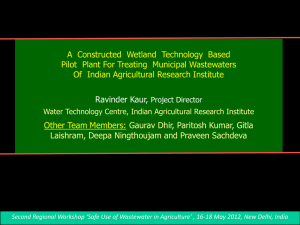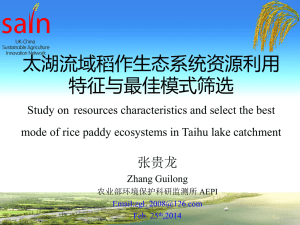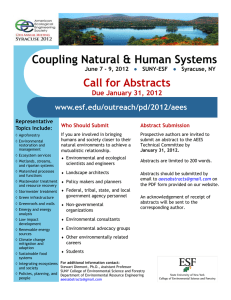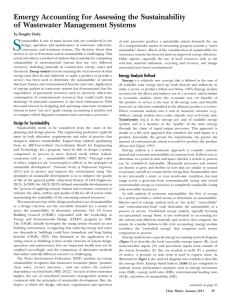Advance Journal of Food Science and Technology 7(12): 921-925, 2015
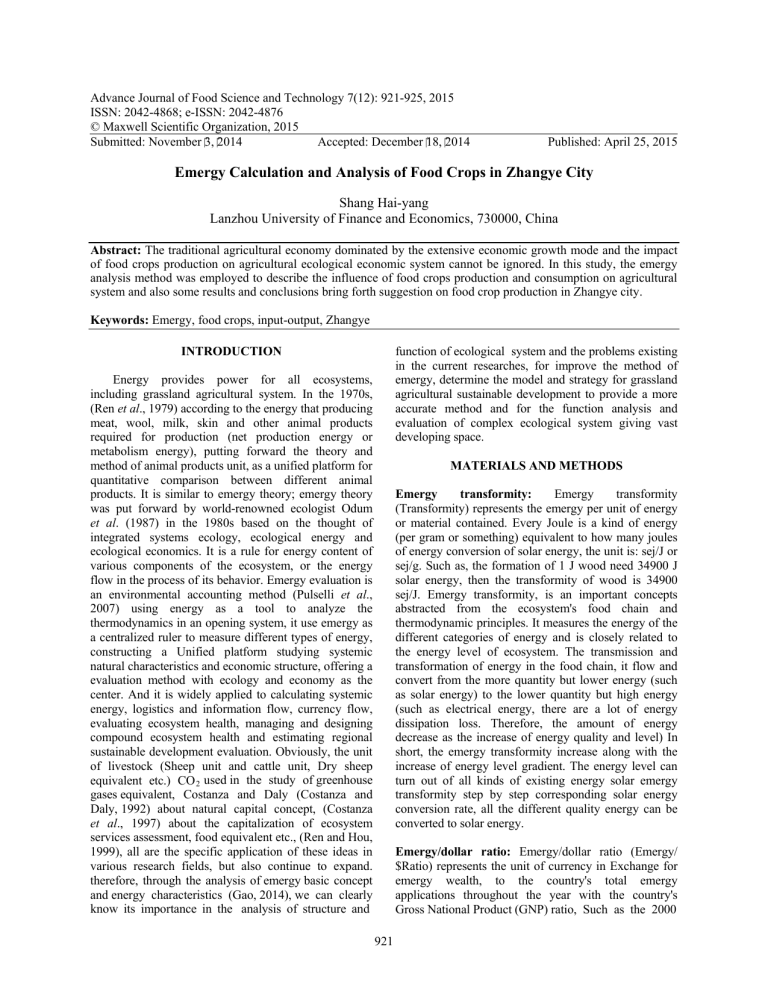
Advance Journal of Food Science and Technology 7(12): 921-925, 2015
ISSN: 2042-4868; e-ISSN: 2042-4876
© Maxwell Scientific Organization, 2015
Submitted: November
3, 2014 Accepted: December 18, 2014
Published: April 25, 2015
Emergy Calculation and Analysis of Food Crops in Zhangye City
Shang Hai-yang
Lanzhou University of Finance and Economics, 730000, China
Abstract: The traditional agricultural economy dominated by the extensive economic growth mode and the impact of food crops production on agricultural ecological economic system cannot be ignored. In this study, the emergy analysis method was employed to describe the influence of food crops production and consumption on agricultural system and also some results and conclusions bring forth suggestion on food crop production in Zhangye city.
Keywords: Emergy, food crops, input-output, Zhangye
INTRODUCTION
Energy provides power for all ecosystems, including grassland agricultural system. In the 1970s,
(Ren et al ., 1979) according to the energy that producing meat, wool, milk, skin and other animal products required for production (net production energy or metabolism energy), putting forward the theory and method of animal products unit, as a unified platform for quantitative comparison between different animal products. It is similar to emergy theory; emergy theory was put forward by world-renowned ecologist Odum et al . (1987) in the 1980s based on the thought of integrated systems ecology, ecological energy and ecological economics. It is a rule for energy content of various components of the ecosystem, or the energy flow in the process of its behavior. Emergy evaluation is an environmental accounting method (Pulselli et al .,
2007) using energy as a tool to analyze the thermodynamics in an opening system, it use emergy as a centralized ruler to measure different types of energy, constructing a Unified platform studying systemic natural characteristics and economic structure, offering a evaluation method with ecology and economy as the center. And it is widely applied to calculating systemic energy, logistics and information flow, currency flow, evaluating ecosystem health, managing and designing compound ecosystem health and estimating regional sustainable development evaluation. Obviously, the unit of livestock (Sheep unit and cattle unit, Dry sheep equivalent etc.) CO
2
used in the study of greenhouse gases equivalent, Costanza and Daly (Costanza and
Daly, 1992) about natural capital concept, (Costanza et al ., 1997) about the capitalization of ecosystem services assessment, food equivalent etc., (Ren and Hou,
1999), all are the specific application of these ideas in various research fields, but also continue to expand. therefore, through the analysis of emergy basic concept and energy characteristics (Gao, 2014), we can clearly know its importance in the analysis of structure and function of ecological system and the problems existing in the current researches, for improve the method of emergy, determine the model and strategy for grassland agricultural sustainable development to provide a more accurate method and for the function analysis and evaluation of complex ecological system giving vast developing space.
MATERIALS AND METHODS
Emergy transformity: Emergy transformity
(Transformity) represents the emergy per unit of energy or material contained. Every Joule is a kind of energy
(per gram or something) equivalent to how many joules of energy conversion of solar energy, the unit is: sej/J or sej/g. Such as, the formation of 1 J wood need 34900 J solar energy, then the transformity of wood is 34900 sej/J. Emergy transformity, is an important concepts abstracted from the ecosystem's food chain and thermodynamic principles. It measures the energy of the different categories of energy and is closely related to the energy level of ecosystem. The transmission and transformation of energy in the food chain, it flow and convert from the more quantity but lower energy (such as solar energy) to the lower quantity but high energy
(such as electrical energy, there are a lot of energy dissipation loss. Therefore, the amount of energy decrease as the increase of energy quality and level) In short, the emergy transformity increase along with the increase of energy level gradient. The energy level can turn out of all kinds of existing energy solar emergy transformity step by step corresponding solar energy conversion rate, all the different quality energy can be converted to solar energy.
Emergy/dollar ratio: Emergy/dollar ratio (Emergy/
$Ratio) represents the unit of currency in Exchange for emergy wealth, to the country's total emergy applications throughout the year with the country's
Gross National Product (GNP) ratio, Such as the 2000
921
Adv. J. Food Sci. Technol., 7(12): 921-925, 2015 year, China emergy/dollar ratio 4.94 e+12 sej/US $ and reflects the purchasing power of money. Predominantly agrarian developing countries, the direct use of a lot of free domestic natural resources, there is no or little useful money to buy the resources of other countries products, GNP is low at the same time, less the amount of money in circulation in the economic field, thus developing countries have higher emergy/dollar ratio. In
Net emergy yield ratio: Net emergy yield ratio (Net emergy yield the wire, NEYR) is output emergy of the system (emergy of human economic and social feedback and Self-system’ feedback) and the feedback emergy ratio. Characterization system output emergy contribution to the economic size, measure productivity of the system. Namely: NEYR = Y/ ((NF+RF+S) and these countries with less money to buy more emergy wealth, conversely, the emergy/dollar ratio of developed countries is far lower than the developing countries, their high GNP, using money to buy more resource production. the similar to economic analysis of the "Output-input ratio" (output/input ratio). EYR is higher, showing that system can obtain certain economic emergy input,
Produced products to higher emergy (output emergy), namely the higher production efficiency of the system.
Environmental loading ratio: Environmental loading
Emergy dollars: Emergy dollars (Emergy dollars, abbreviated: EM$) is the ecological economic system’s emergy of the material and energy conversion into money, which is equivalent to how much currency, also known as the macro-economic value, the conversion method is emergy divided by the emergy/dollar ratio, ratio (Environmental Loading Ratio, ELR) is nonrenewable resources emergy inputs and renewable resource emergy input ratio, Namely: ELR = (N+NF) /
(R+RF+S) response to environmental pressure on the system, is a warning to the system, if the system under the larger environment load rater for a long time, the system will be irreversible degradation of function or loss. reflecting the real value of a product, including setting in the product of human labor and the value of environmental resources. If a particular emergy flow is the economy system constitute part of the real wealth, so that this part of the purchasing power of the system depends on the emergy flow. For example, agriculture in one of the country's annual output emergy accounted for
10% of the total, the country's economic output (GEP)
Renewable resource emergy ratio: Renewable resource emergy ratio (Renewable resource emergy ratio) is the total environmental emergy of system and the total emergy input of system ratio.
Self-system’ feedback ratio: Self-system’s feedback of 10% depends on the volume of agricultural output emergy. This part of economic output is determined by the emergy, which is known as the emergy dollars. The emergy unit of the practical application is solar joule
(sej), so "emergy dollars" is actually "solar emergy dollars". Popular terms, so-called emergy dollars system refers to a certain emergy to the contribution to economic convert currency, equivalent to how much currency. Proceeds of such emergy dollars, not market value of currency in circulation, just indicates that the emergy "is equivalent to" how much currencies. Emergy dollars is to explore the ideal scale economy from a macroscopic view, it can be used to measure the economic environment, the goods and services.
Emergy investment ratio: Emergy investment ratio ratio (Self-system’ feedback ratio, SFER) is Selfsystem’ feedback energy and output emergy ratio,
Namely: SFER = S/Y characterization system selforganizing abilities and energy, reflecting the system's own foundation for sustainable development. The larger the ratio is showing the greater the mode of selforganization’s ability, the higher the viability, the better basis to realize the sustainable development of the internal foundation.
Emergy-based for sustainable index: ESI is ratio of the net emergy yield ratio and environmental loading ratio, namely the sustainability of the EIS = NEYR/ELR emergy is the sustainability of characterization system of EIS, The high ESI shows the system emergy utilization efficiency is high, the environmental pressure is small, sustainable development is strong; The small
EIS shows that system emergy use efficiency is low, the (Emergy Investment Ratio, EIR) is buying resources emergy (nonrenewable industrial auxiliary energy and renewable organic energy) and the system of own resources emergy (natural resources emergy and feedback emergy) ratio, Usually used to measure load of the system with their own resources to economic activity, Its value is greater, the higher the degree of economic development system, environmental load environmental pressure is big, sustainable development is low.
Emergy analysis of food crops in Zhangye: Zhangye is located in the middle reaches of heihe river, the concentration of 95% cultivated land of the whole basin, correspondingly larger degree; lower value indicates lower levels of economic development, the stronger dependence on system of own resources. Emergy investment rate can also be referred to as "economic emergy/environmental emergy ratio."
91% of the population and 80% of gross domestic product, is the key of the heihe river basin ecological protection. Late twentieth century, heihe river basin drought crisis of water scarcity, land desertification and ecological imbalance has attracted national attention. In
February 2001, the 94 th
Prime Minister's Office
922
following the implementation of recent treatment to the heihe River, through the water-saving transformation in
Adv. J. Food Sci. Technol., 7(12): 921-925, 2015
Table 1: Emergy input of agricultural in Zhangye (sej)
2008 irrigation district, returning farmland to forests and grassland and economic structural adjustment measures and achieve when to1.58 billion m
3
of water in the upper reaches of the heihe river, downstream discharged 950 million m
3
, in order to curb the trend of ecological deterioration in Erjina. Since implementation of government planning in heihe basin, Gansu province and Zhangye city seriously implement State Prime
Minister Office spirit, focus on the perseverance to the establishment and perfection of water resources unified management and ecological construction and environmental protection system, vigorously adjustment economic structure and agricultural planting structure, promoting water-saving society construction, It has
Renewable resources
Solar radiation
Rainfall potential
Subtotal
Nonrenewable resources
Pesticides
Plastic
Subtotal
Renewable organic energy
Labor
1.66E+19
4.94E+17
1.71E+19
Surface soil loss 2.63E+19
Nonrenewable industrial auxiliary energy
Electric power 1.12E+20
Farm machinery
Fertilizer
5.09E+16
3.72E+22
6.66E+20
7.94E+20
3.88E+22
Animal power
Subtotal
Total
5.38E+21
1.96E+20
5.58E+21
4.44E+22 finished water diversion task in heihe for ten consecutive years, accumulating total more than 100 m
3 of water diversion to the downstream, accounting for
57.5% of the heihe river hydrologic, extension sea water
Table 2: Emergy output of agricultural in Zhangye (sej)
2008 area from east to west exceeds 1950s level, the downstream of Erjin ecological environment improved obviously.
In 2008, total 1.28 million people in Zhangye, including agricultural population of 840,000 people, urban population is 440,000; GDP totaled 16.986 billion
Yuan for the whole year, of which the first industrial added to value of 4.923 billion Yuan (including 4.854 billion Yuan in the added value of agriculture), the second industry added to value of 6.503 billion Yuan
(including 5.058 billion Yuan in industrial added value), the third industrial added to value 5.56 billion Yuan, three per 29:38:33, per capita GNP 13285, 9315 Yuan of disposable income per capita of urban residents, per capita net income of rural residents 4515. Now there are
5.86 million
μ of cultivated land area (5.2 million μ of irrigated area, mountains, dry lands 660,000
μ) and 3.8 million
μ irrigation in the whole city. In 2008 the city's grain output reached 950 million kg (660 million kg for export).
Wheat
Corn
Oil
Vegetables
Fruit
Potato
Rice class
Sugar beet
Beans
Melons
Pork
Mutton
Beef
Poultry meat
Dairy
Hair type
Aquatic products
Herbs
Wood and wooden mouth
5.91E+19
5.81E+20
1.39E+21
6.71E+19
3.14E+20
1.80E+18
2.36E+18
1.40E+19
5.73E+19
1.82E+18
1.56E+21
2.83E+21
4.84E+21
2.21E+21
2.15E+20
1.72E+21
2.60E+19
4.34E+19
5.40E+21
2.13E+22
2012
1.66E+19
4.94E+17
1.71E+19
2.63E+19
1.12E+20
5.09E+16
3.72E+22
6.66E+20
7.94E+20
3.88E+22
5.38E+21
1.96E+20
5.58E+21
4.44E+22
2012
From Table 1, we can see that Zhangye agricultural ecological economic system in 2008, 2012 input to the
Based on emergy theory analysis steps and related concept that described above, we can analyze the input-
5.91E+19
5.81E+20
1.39E+21
6.71E+19
3.14E+20
1.80E+18
2.36E+18
1.40E+19
5.73E+19
1.82E+18
1.56E+21
2.83E+21
4.84E+21
2.21E+21
2.15E+20
1.72E+21
2.60E+19
4.34E+19
5.40E+21
2.13E+22 total emergy is 5.77 E+23 sej, 5.77 E+23 sej.
Nonrenewable industrial auxiliary emergy have maximum input (87%), renewable emergy (renewable environmental resources and renewable organic) inputs output statue of agricultural eco-economic system in
Zhangye. Due to data constraints, we only analyze the input-output statue of agricultural eco-economic system in Zhangye in 2008 and 2012 year.
Table 1, in order to avoid repeated computation, the energy input of the same nature only takes its maximum
(12% of total input) in second place.
Considering that many of the agricultural ecosystem product output is not single, the same production process may have many different product output, Due to the by-products and the main products deriving from the same production process in the emergy analysis and have common emergy content, therefore in the value according to the emergy theory. Nonrenewable resources include surface soil loss. Nonrenewable industrial auxiliary energy includes diesel, fertilizer calculation of emergy output only take one, namely the planting output to remove the straw output, livestock husbandry output remove dung output.
By the composition of product emergy according to (nitrogen fertilizer, phosphate fertilizer, potash fertilizer etc, purified volume) pesticides, compound fertilizer, farm machinery, renewable organic energy include labor, animal power. Solar emergy is equal to the original ecological flow emergy multiplied by the solar emergy transformity (Megegaki, 2008). the international average productivity (i.e., emergy transformity), the system (Table 2) shows that the zhangye agricultural system in 2008, 2012 total emergy output are 2.13 E+22, 2.13 E+22 respectively, farming, forestry, livestock husbandry and fishery output emergy
923
Adv. J. Food Sci. Technol., 7(12): 921-925, 2015 followed by 2.18E+21, 5.71E+21, 1.34E+22, 2.06E+19, proportion are 10.21, 26.77, 62.69 and 0.32%, respectively. Agriculture of the area is mainly dominated by livestock husbandry and forestry, but farming and fisheries shares are too small. This match and function of ecological economic system, understand the environmental impact of human society.
RESULTS AND DISCUSSION the actual situation that returning farmland to forest
(grassland) engineering, construction engineering, construction of wetland project, development of beef
Utilization of resources, correctly handle the relationship between economic activities of human cattle breeding industry in Zhangye for mang years, further increasing the area of automatic control, regulation, stability and the ability of feedback.
In the agricultural output emergy, grain, oil and society and the natural environment, sustainable development provides science basis; on the other hand, through the emergy comparative study of indicators and other countries or regions, we can understand the sugar fruit and vegetable output emergy accounted for
57.9, 35 and 6.2%, respectively, crop planting structure mainly dominated by food crops, which is consistent with the actual situation of Zhangye city as the national commodity grain base. Oil crops accounted for 34.7% in potential for economic development of a country or a region, assess its position among other countries and regions in the world (Mu et al ., 2013). In order to define the development level and situation of the agricultural ecological economic system in Zhangye, set up a system that can reflect the development status of emergy index system, namely the emergy input and output analysis table, as shown in Table 3. the agricultural output emergy, followed by wheat and corn 25, 21.4%, fruits and vegetables accounted for
6.2%. Products in oil crops and beans in grain the highest value of the solar emergy, furthering expand the planting scale and improve the commercial standard.
The oasis livestock products output emergy value is very high, which indicates that the development of livestock husbandry is very fast, the effect is very obvious. The developed country livestock husbandry output value accounted for the proportion of total
From Table 3, Zhangye agricultural eco-economic system in 2008, 2012 net energy output (NEYR,
EmY/EmT) lower, just 0.5%, while the region (1999) net energy output is 1.9 in 10 years ago. The net emergy output ratio reflects whether the system in obtaining economic input has advantage, which reflects the sustainable development situation of the system to some extent (Mu et al ., 2013). Odum et al . (1987) believes that the value should be between 1~6, if a system of net agricultural output value in the above 50%, the market space and development potential is very great, it is also one of the important breakthroughs of agricultural industry structure adjustment. The oasis livestock emergy output is less than 1, then the system's emergy will not increase; If a system of net emergy output less than the net emergy output of another system, so the system gain economic investment opportunities and will products output value 62.69% of total output emergy, of which pork accounted for 11.7% of livestock production, lamb 21.2% and beef 36.2%. Under the national major policies of the returning farmland to forest and grass, changing farming idea, increasing be less than the amount of another system, then the system gain economic investment opportunities and number the amount will be less than the other systems, thus reducing the system gain economic input emergy investment in science and technology of aquaculture, eventually increasing the benefit of the livestock husbandry is the way of sustainable development.
The quantity of oasis agricultural products is large competition ability, eventually be replaced by a high net emergy output of system. From this point of view, it should be more net energy output of agricultural ecoeconomic system in Zhangye region in order to enhance in Zhangye, in addition to meet the needs of the farmer's life, most of the food, vegetables, fruits, meat and other products on primary and raw products flow into the market at home and abroad, the added value of the products is very low, it is difficult to improve the its ability to obtain outside investment.
Zhangye environmental loading ratio of agricultural eco-economic system (ELR, (EmF+EmN) / (EmR+
EmR1) rose from 1.564 in 2008 to 6.94 in 2012, increasing 4.5 times over the past 5 years. This aspect efficiency of agricultural production, influence the farmers' enthusiasm for production, which restricts the sustainable development of agriculture. Under the condition of market economy, the depth development of agricultural products processing and Proliferation have become an important part in the development of agricultural production.
The Zhangye agricultural produce depth is also dem onstrated by the hugepotentials and broad prospects for development. Through emergy analysis conclusions a series of emergy indices, the ecological economic system of various ecological flow unified emergy scale, on one hand, it can quantitative analysis the structure
Table 3: Emergy analysis agricultural in Zhangye (sej)
EmR
EmN
Eml = EmR + EmN
EmRl
EmF
EmT = EmF + EmRl
EmU = Em1 + EmT
Y1
Y2
Y3
Y4
Em = Y1 + Y2 + Y3 + Y4
2008
1.71E+19
2.63E+19
4.35E+19
5.58E+21
3.88E+22
4.44E+22
4.44E+22
2.49E+21
5.40E+21
1.34E+22
2.60E+19
2.13E+22
2012
1.71E+19
2.63E+19
4.35E+19
5.58E+21
3.88E+22
4.44E+22
4.44E+22
2.49E+21
5.40E+21
1.34E+22
2.60E+19
2.13E+22
924
Adv. J. Food Sci. Technol., 7(12): 921-925, 2015 shows that the higher the skill level of the system in terms of emergy use, on the other hand, the pressure on the local environment is also reflected in constant increase, very high environmental load rates mean more critical issues to completely solved and protection the health of agricultural eco-economic system in Zhangye. economic activity has a greater pressure on local environment and may even exceed the carrying capacity of eco-environment. The characteristics of environmental load of agricultural eco economic system
ACKNOWLEDGMENT
This study was supported by “under the perspective of water footprint in inland river basin in the northwest resident low water consumption mode study" (No:
41201595), “Research on livelihood risk of farmers in in Zhangye area of increasing remind us that we should take some measures to stabilize the agricultural environment load ratio.
The emergy sustainability index (ESI, NEYR/ELR)
Shiyang River Basin” (No: 41401653), “Research on the Ecological Compensation Mechanism of the Inner
River Basins of the Northwestern China-A Case Study of Shiyang River Basin” (No: 41171116) and General of agricultural ecological economic system in Zhangye is going down gradually (from 1.216 in 2008, to 0.13 in
2012), which reflects its agricultural ecological economic system nonrenewable environmental input
Research on Social Sciences of Ministry of Education of the PRC China (No: 12YJAZH110). and output capacity of auxiliary emergy coming down.
According to Brown. M.T and Ulgiati on the definition of ESI, 1<ESI<10, shows that the system is full of vitality and development potential, ESI>10 is a symbol
REFERENCES
Costanza, R. and H.E. Daly, 1992. Natural capital and of economic underdevelopment, when ESI<I is a consumer economy system. Therefore, the current development situation of agricultural ecological system is not optimistic in Zhangye. sustainable development. Conserv. Biol., 6: 37-46.
Costanza, R., R. d’Arge, R. de Groot, S. Farber,
M. Grasso, B. Hannon, K. Limburg, S. Naeem,
R.V. O’Neill, J. Paruelo, R.G. Raskin, P. Sutton and M. van den Belt, 1997. The value of the world’s ecosystem services and natural capital.
CONCLUSION
The sustainable development of agriculture
Nature, 387: 253-259.
Gao, J., 2014. Research of broken wire rope detection system based on LabVIEW. Adv. J. Food Sci.
Technol., 6(4): 433-437. economy is the only way to achieve comprehensive construction harmonious society and building a socialist harmonious society and realize modernization in northwest inland river basin in arid region of Zhangye
Megegaki, A., 2008. Valuation for renewable energy: A comparative review. Renew. Sust. Energ. Rev., 12:
2422-2437.
Mu, H., X. Feng and K.H. Chu, 2013. Emergy synthesis city. The traditional agricultural economy dominated by the extensive economic growth mode, the development of unsustainable is increasingly highlighted and in the development of agricultural ecological economic system of the agroecosystem in Yan'an Area of China.
Agroecol. Sustain. Food Syst., 37(10):
1103-1119.
Odum, H.T., E.C. Odum and M. Blisset, 1987. Ecology contradiction problems cannot be ignored, we must strengthen the investment focus on key elements influence the development of agricultural eco economic system. Especially for Zhangye which is located in the and economy: Emergy analysis and publicly in
Texas L.B. Johnson. School of Public Affairs and
Texas Dept. of Agriculture. University of Texas,
Austin. arid area, due to the fragile ecological environment, the shortage of water resources, the ecological environment carrying capacity is small, environmental problems caused by social and economic development are more
Pulselli, R.M., M. Rustici and N. Marchettini, 2007. An integrated framework for regional studied: Emergy based spatial analysis of the Province of Cagliari.
Environ. Monit. Assess., 133: 1-13. prominent. At the same time, because the city is a big agricultural city, how to solve the key elements affecting the development of Zhangye City agricultural economic system-the water problem, change the traditional
Ren, J. and F. Hou, 1999. Change the traditional view of food, food equivalent on a trial basis. J. Grass
Ind., 8: 55-75. extensive agriculture utilization mode of water resources, improve water use efficiency and reduce the problem of water resources waste, become the most
Ren, J., Z. Hu and X. Mou, 1979. On grassland production and its new index for evaluationlivestock units [J]. Chinese J. Animal Husbandry,
2: 21-27.
925

